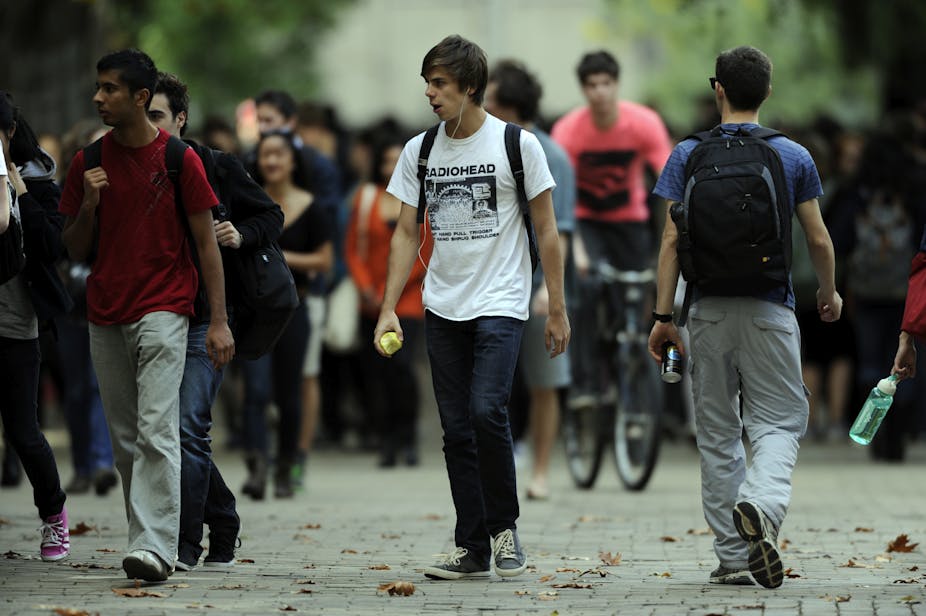In contemporary Australia, post-school education is necessary for most well-paid jobs. And so who gets access to education is important. University of Melbourne Vice-Chancellor Glyn Davis echoed many people’s concerns when he asked whether university fee deregulation will deter potential students from low socioeconomic status backgrounds. However, if we look at the evidence, we see this isn’t necessarily the case.
Is university for everyone?
Important as this issue is, another question needs answering first: is higher education everyone’s best option? While on average people with higher education qualifications are better off than others, some students never complete the courses they start, and not all graduates get good jobs. Even free university courses can cost too much, if students could have used their time more effectively.
Once students are enrolled, low socioeconomic status does not in itself add significantly to non-completion risks or poor financial returns after graduation. But low socioeconomic background students are over-represented among school leavers applying with lower ATARs, and lower-ATAR university students are in turn over-represented among those who don’t complete their courses.
For students entering a bachelor degree with an ATAR under 60, six-year completion chances are around 50%, compared to nearly 90% for students in the 95-plus ATAR group. All the published completions data includes people who are still enrolled, but for lower-ATAR students the final non-completion rate is estimated to be around 40%. It isn’t social progress to leave someone with a student debt but no degree, if with better advice they would have made a different educational decision.
Policy change means more people are making difficult choices between higher education and other options. Since 2012 public universities can take unlimited numbers of bachelor-degree students. The share of offers to students with ATARs below 60 has increased from 10% in 2011 to 15% in 2014. Young people with lower ATARs are being diverted from vocational education and work to higher education.
We need more research to help these people decide whether or not higher education is the right option. School leavers with ATARs between 40 and 60 probably range from slightly below to slightly above median academic ability (leaving aside debates about exactly what ATAR measures). This is low by the standards of traditional elite models of higher education, but not compared to the population as a whole.
One hypothesis based on this observation is that graduates from this starting point might find themselves at the lower end of the range of graduate incomes, but at the higher end of people who pursue vocational education diplomas or Certificate III/IV qualifications.

At Grattan we are at the early stages of work on this idea, but for example a male whose highest qualification is a diploma or advanced diploma with career income at the 60th percentile (that is, 60% of people with this qualification earn less and 40% earn more) earns more than a male bachelor degree graduate at median earnings or less. Once educational costs and risks are taken into account, the diploma or advanced diploma route may be the better financial option for lower-ATAR school leavers.
Let students decide the best path for their situation
Despite increases in lower-ATAR students going to university, broadly speaking young people from all socioeconomic backgrounds look to be making sensible decisions about their realistic alternatives. There are fewer university applications from young people with lower ATARs compared to their higher-ATAR classmates. Among those who do apply, there are similar offer acceptance rates across different socioeconomic levels.
Application data does not let us compare applicants with the original pool of low socioeconomic school leavers, but this can be done in the Longitudinal Surveys of Australian Youth (LSAY). The figure below shows that at ATARs above 70 there are virtually no socioeconomic differences in university attendance. All these young people make very similar, and overwhelmingly positive, judgements about university compared to other options. There is more divergence between the socioeconomic groups at lower ATAR levels where the risks of going to university are higher, but the pattern of ATAR as the dominant driver of attendance remains.

Higher fees don’t necessarily deter poorer students
With every increase in tuition charges the same claims are made about more adverse impacts on low than high socioeconomic students. The LSAY data reported above is based on university attendance in 2012 among people who were 15 in 2006, the year after the third major increase in university costs since free education. As on the previous two occasions, the empirical evidence did not support concerns that low socioeconomic background people would be particularly affected by the price change.
Intuitive theories about low socioeconomic prospective students were again shown to lack predictive power during the English higher education reforms of 2012. Fees at most universities nearly tripled to £9,000, which creates total course costs in the range I expect will eventually be charged here under fee deregulation. Yet low socioeconomic application rates and enrolment shares actually increased.
Of course it is still possible that Australia will be different this time. But local and English experience suggest that we need a new theory of low socioeconomic student behaviour. Their decision-making in a higher education system with income-contingent loans is not impaired by their family financial histories or by debt phobias. Previous classroom achievement rather than social class best explains observed patterns of university enrolment.
This policy history does not suggest any need to spend large sums of public money reducing university fees to influence low socioeconomic student behaviour. Instead, we need to improve our understanding of the relative costs, benefits and risks of higher education compared to its alternatives and convey the findings to prospective students.

